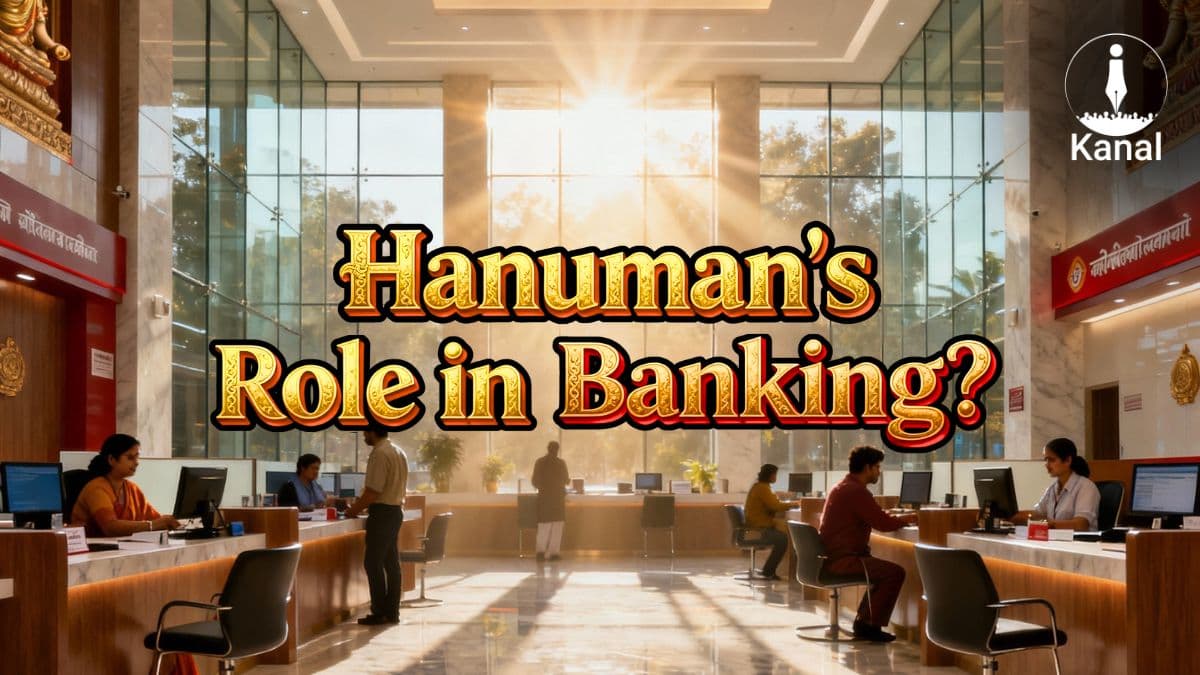Hanuman in a Banker’s Training? Debate Erupts Over ‘Mission Karmayogi’ and Religious Metaphors in Banking
The Union Government’s new behavioural training module under the Rashtriya Karmayogi Mission has stirred debate within India’s banking industry for weaving Hindu mythological references into official training content. Unions allege it undermines the secular nature of public sector banks.

Author: Abhivad
Published: October 21, 2025
What is Hanuman, the mythological character from the Ramayana, doing in a professional training module for bankers? This question has triggered a wave of criticism as public sector bank employees were recently asked to undergo government-mandated training under the Mission Karmayogi initiative. The programme begins with a video narrating how Hanuman realised his “true inner strength” — a metaphor the government describes as motivational, but bank unions see as an attempt to mix religion with professional instruction.
Advertisement
The Karmayogi Initiative
Launched under the Rashtriya Karmayogi Mission, the training is coordinated by the Capacity Building Commission (CBC) to transform governance across public institutions. According to the official CBC website, the mission seeks to shift the approach of government employees “from rule-based governance to role-based governance” and “from Karmachari to Karmayogi.”
Advertisement
The digital training, conducted via the iGOT Karmayogi platform, requires participants to download an app and complete online behavioural modules. The government has reportedly allocated ₹510 crore for this nationwide capacity-building initiative, which has already been rolled out among central government staff.
Religious Metaphors in Focus
The training module begins with a narrated story from the Ramayana:
“Hanuman had forgotten his true inner power and hence was standing there not knowing how much he could contribute. The Ramayana tells us that Jambavan reminded Hanuman of his true inner power. Once Hanuman remembered this and accepted that he had this power, he was able to make a big difference in helping to bring back Mother Sita… Similarly, in each one of us there is a tremendous inner power which, if realised, can increase our power to contribute.”
Such moral parables, drawn from Hindu epics like the Ramayana and Mahabharata, feature throughout the course. While the government promotes these as illustrative tools for ethical work culture, critics argue that their religious tone may compromise the secular character of public institutions such as banks.
Bank Unions Raise Objections
The All India Bank Employees’ Association (AIBEA) has strongly objected to the inclusion of religious content in the module. In a letter dated 10 October 2025 addressed to M. Nagaraju, Secretary, Department of Financial Services (DFS), AIBEA General Secretary C.H. Venkatachalam described the initiative as “an unwarranted attempt to mix up religion.”
When Kanal reached out to C H Venkatachalam for a comment on the issue, he reiterated the content of the letter. “Public sector banks are secular institutions and should not be used to indirectly propagate any one religion. This has already hurt the religious sentiments of many employees in the banks”, he said.
The letter also questioned the rationale for an additional behavioural programme when all banks already have their own training systems. It highlighted that employees are under heavy workload and mental stress due to staff shortages, arguing that recruitment — not moral instruction — should be the government’s priority.
The Bank Employees Federation of India (BEFI) also criticised the move, calling it “a conduit for promoting a soft Hindutva narrative.” BEFI’s All India President S.S. Anil, speaking to Kanal, said: “Mission Karmayogi training programme is a direct attempt to impose the communal agenda of the current ruling dispensation on to the banking industry. It is against the secular principles enshrined in the Constitution. Moreover, metaphors like ‘Karmachari to Karmayogi’ or ‘Hanuman’s true inner power’ are intended to give a sense of divinity to employees’ labour while stripping them of rights like fair wages and benefits.”
“The government wants bankers to regard it as ‘Lord Ram’—or as a divine incarnation—and devote themselves to work without question, just as Hanuman was devoted to Lord Ram. This is absolutely hilarious in that sense”, he added.
Banking and public policy expert Thomas Franco, former General Secretary of AIBOC, also expressed concern. “The attempt to mix up religion in a professional training programme for bankers is mindless. It is part of a communal agenda that goes against constitutional principles. The secular character of the banking sector is central to financial inclusion in India. There are already established training programmes in PSBs — religious elements are certainly not the way to improve professionalism”, he told Kanal.
Broader Questions and Repercussions
Critics fear that embedding religious metaphors into employee training may set a precedent for future government programmes, especially in institutions mandated to remain secular. Proponents of the initiative, however, claim it promotes moral clarity and self-realisation in public service.
The controversy also raises questions about public expenditure priorities, with ₹510 crore being invested in the programme at a time when staff shortages and stress-related burnout are reported across banks.
The debate over Mission Karmayogi underscores a deeper tension between governance reforms and India’s secular institutional framework. As the government pushes ahead with its new training model, the question remains: Where should the line be drawn between faith and professionalism in India’s public institutions?
Advertisement
No comments yet.
